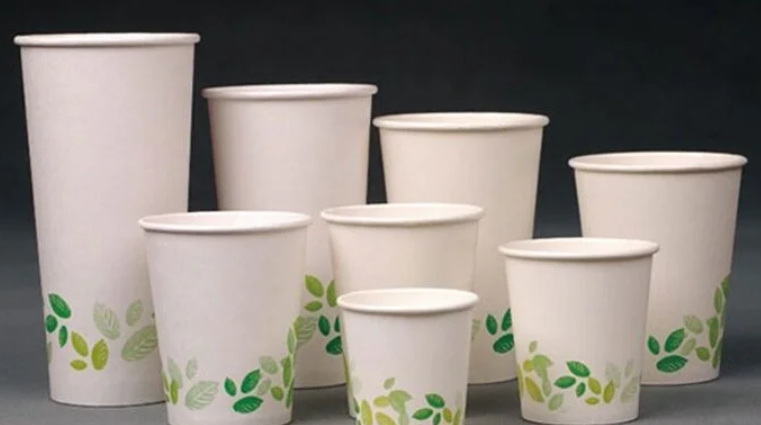
Content Menu
● The Anatomy of a Disposable Cup Plate Making Machine
● Step-by-Step Workflow of a Disposable Cup Plate Making Machine
>> 1. Raw Material Loading and Preparation
>> 2. Forming the Initial Shape
>>> Plate Forming
>>> Cup Forming
>> 3. Bottom and Rim Attachment
>>> Cup Bottom Sealing
>>> Plate Rim Finishing
>> 4. Cutting, Trimming, and Shaping
>> 5. Quality Control and Product Ejection
● Automation and Precision in Disposable Cup Plate Making Machines
● Maintenance and Longevity of Disposable Cup Plate Making Machines
● Environmental Considerations in Disposable Cup Plate Production
● Applications and Versatility of Disposable Cup Plate Making Machines
● The Future of Disposable Cup Plate Making Machines
● Conclusion
● FAQ
>> 1. What training is required to operate a disposable cup plate making machine?
>> 2. How often should lubrication be performed on a disposable cup plate making machine?
>> 3. What power supply is required for a disposable cup plate making machine?
>> 4. Can a disposable cup plate making machine produce different sizes and shapes?
>> 5. How does the machine detect and handle production errors?
Disposable cup plate making machines are the backbone of modern food packaging, enabling the mass production of single-use cups and plates that we encounter daily in cafes, restaurants, and events. These machines blend mechanical engineering, thermal science, and automation to transform raw materials into finished products with remarkable speed and consistency. Understanding how a disposable cup plate making machine works provides insight into the technology behind everyday convenience and highlights the importance of precision in manufacturing.

The Anatomy of a Disposable Cup Plate Making Machine
A disposable cup plate making machine is a sophisticated assembly of interconnected modules, each designed to perform a specific task in the production process. The main components include:
- Raw Material Feeding System: This section holds and unwinds large rolls of coated paper or pre-cut blanks, ensuring a continuous supply to the machine.
- Forming and Molding Units: Equipped with heated dies and molds, these units shape the paper into cups or plates.
- Sealing Mechanisms: Heat and pressure are applied to bond seams and attach bases or rims.
- Cutting and Trimming Tools: High-precision blades or punches cut the paper into the desired shapes and remove excess material.
- Automation and Control Systems: Programmable logic controllers (PLCs), sensors, and servo motors manage the entire process, ensuring accuracy and efficiency.
- Quality Inspection and Ejection Systems: Sensors and cameras monitor product quality, automatically removing defective items.
Each of these modules plays a critical role in ensuring the disposable cup plate making machine operates smoothly and produces high-quality products.
Step-by-Step Workflow of a Disposable Cup Plate Making Machine
1. Raw Material Loading and Preparation
The process begins with the loading of raw materials, typically large rolls of PE-coated or PLA-coated paper. The coating provides the necessary barrier properties, making the final product resistant to moisture and grease. Operators load the rolls onto the feeding system, which unwinds the paper and feeds it into the machine at a controlled rate.
For plate production, the paper may be pre-cut into circular blanks. For cups, the paper is typically slit into rectangular sheets, called "flats," which will later be shaped into cylinders.
2. Forming the Initial Shape
Plate Forming
In plate production, the pre-cut blanks are transferred to the molding station. Here, heated dies press the paper into the desired plate shape. The combination of heat and pressure softens the coating, allowing the paper to conform to the mold. Vacuum suction is often used to ensure even distribution and prevent air pockets, resulting in plates with uniform thickness and crisp edges.
Cup Forming
For cup manufacturing, the rectangular flats are wrapped around a cylindrical mandrel. The edges of the paper are overlapped and sealed using heat, forming the cup body. The disposable cup plate making machine uses a cam-driven mechanism to synchronize this process, ensuring that each cup is formed with precision and consistency.
3. Bottom and Rim Attachment
Cup Bottom Sealing
Once the cup body is formed, a separate disc is punched from the coated paper and positioned at the bottom of the cylinder. The machine applies heat and pressure to seal the disc to the body, creating a leak-proof base. This step is critical for ensuring the cup's integrity, especially when holding hot or cold liquids.
Plate Rim Finishing
For plates, the edges are rolled or curled to create a smooth rim. Some machines also emboss the rim for added strength and aesthetics. This not only enhances the plate's appearance but also improves its structural rigidity.
4. Cutting, Trimming, and Shaping
After forming and sealing, the products move to the cutting and trimming section. Here, high-speed blades or punching dies remove excess material and refine the shape. For cups, this step ensures a uniform height and a smooth rim, while for plates, it guarantees a consistent diameter and edge finish.
5. Quality Control and Product Ejection
Modern disposable cup plate making machines are equipped with advanced quality control systems. Optical sensors and cameras inspect each item for defects such as incomplete seals, misaligned edges, or irregular shapes. Defective products are automatically ejected from the production line, while approved items are counted and stacked for packaging.

Automation and Precision in Disposable Cup Plate Making Machines
The heart of a disposable cup plate making machine lies in its automation and precision controls. These machines are designed to operate at high speeds, often producing thousands of items per hour. To achieve this level of productivity without compromising quality, several technologies are integrated:
- Programmable Logic Controllers (PLCs): These digital computers control the sequence of operations, manage timing, and respond to sensor inputs. PLCs allow for easy adjustments and troubleshooting.
- Servo Motors and Drives: These provide precise control over movement, ensuring that paper is fed, formed, and cut with exact timing.
- Temperature Control Systems: Maintaining the correct temperature in the heating elements is crucial for effective sealing and forming.
- Real-Time Monitoring: Sensors continuously monitor critical parameters such as paper alignment, pressure, and temperature, allowing for immediate corrections if deviations are detected.
This level of automation not only increases efficiency but also reduces the need for manual intervention, minimizing the risk of human error and ensuring consistent product quality.
Maintenance and Longevity of Disposable Cup Plate Making Machines
To keep a disposable cup plate making machine running at peak performance, regular maintenance is essential. Proper care extends the lifespan of the equipment and prevents costly downtime. Key maintenance tasks include:
- Daily Cleaning: Removing paper dust and debris from the dies, molds, and sensors prevents blockages and ensures smooth operation.
- Lubrication: Applying the recommended lubricants to moving parts such as cams, gears, and bearings reduces friction and wear.
- Inspection of Electrical Components: Checking wiring, sensors, and PLC connections for signs of wear or corrosion helps prevent electrical failures.
- Replacement of Wear Parts: Components like cutting blades, heating elements, and pneumatic hoses should be monitored for signs of wear and replaced as needed.
A well-maintained disposable cup plate making machine can operate reliably for many years, delivering consistent results and minimizing the risk of production interruptions.
Environmental Considerations in Disposable Cup Plate Production
As environmental awareness grows, manufacturers of disposable cup plate making machines are adapting their designs to support sustainable practices. Key developments include:
- Use of Biodegradable Materials: Machines are increasingly compatible with PLA-coated and other compostable papers, reducing the environmental impact of disposable products.
- Energy Efficiency: Modern machines are designed to minimize energy consumption through improved insulation, efficient motors, and optimized heating systems.
- Waste Reduction: Precision cutting and real-time monitoring help minimize material waste, while automated stacking and packaging reduce the need for additional handling.
These innovations ensure that disposable cup plate making machines remain relevant in an era of increasing environmental responsibility.
Applications and Versatility of Disposable Cup Plate Making Machines
Disposable cup plate making machines are used in a variety of settings, from large-scale manufacturing plants to smaller workshops. Their versatility allows for the production of a wide range of products, including:
- Paper Cups: For hot and cold beverages, available in various sizes and designs.
- Paper Plates: Used for serving food at events, parties, and takeout establishments.
- Custom Shapes: Some machines can be equipped with custom molds to produce unique shapes and sizes, catering to specific customer requirements.
The ability to quickly switch between different product types and sizes makes these machines a valuable asset for businesses seeking to meet diverse market demands.
The Future of Disposable Cup Plate Making Machines
The disposable cup plate making machine industry continues to evolve, driven by advances in automation, materials science, and environmental regulations. Future trends include:
- Integration with Smart Manufacturing Systems: Machines will become more connected, allowing for remote monitoring, predictive maintenance, and integration with supply chain management systems.
- Enhanced Sustainability Features: Expect greater compatibility with recycled and renewable materials, as well as further reductions in energy and water usage.
- Increased Customization: Advances in mold design and digital printing will enable more personalized and branded disposable products.
These developments will ensure that disposable cup plate making machines remain at the forefront of food packaging innovation.
Conclusion
Disposable cup plate making machines are marvels of modern engineering, combining mechanical, thermal, and electronic systems to produce high-quality single-use products at scale. From raw material feeding to forming, sealing, cutting, and quality inspection, every step is meticulously controlled to ensure efficiency and consistency. As technology advances and environmental concerns grow, these machines are adapting to support sustainable practices and meet the evolving needs of the market. Proper maintenance and operator training are essential for maximizing their lifespan and performance, making them indispensable tools in the food packaging industry.

FAQ
1. What training is required to operate a disposable cup plate making machine?
Operating a disposable cup plate making machine requires both technical and practical training. Operators must learn how to load raw materials, set up molds and dies, adjust temperature and pressure settings, and interpret error messages from the PLC system. Most manufacturers provide comprehensive training during installation, covering routine maintenance, troubleshooting, and safety protocols. Continuous learning is encouraged to keep up with technological updates and best practices.
2. How often should lubrication be performed on a disposable cup plate making machine?
Lubrication is critical for the smooth operation of moving parts such as cams, gears, and bearings. For most disposable cup plate making machines, lubrication should be performed every 48 to 72 hours, depending on the intensity of use and the manufacturer's recommendations. Regular lubrication prevents excessive wear, reduces friction, and extends the life of key components.
3. What power supply is required for a disposable cup plate making machine?
Most industrial disposable cup plate making machines require a stable three-phase 380V electrical connection. The energy consumption typically ranges from 10 to 15 kilowatts per hour, depending on the machine's size, speed, and features. It is essential to ensure that the facility's electrical system can handle the load and that proper safety measures are in place to prevent electrical hazards.
4. Can a disposable cup plate making machine produce different sizes and shapes?
Yes, modern disposable cup plate making machines are designed for versatility. By changing molds, dies, and adjusting machine settings, operators can quickly switch between different sizes and shapes of cups or plates. The changeover process usually takes between 15 and 30 minutes, allowing manufacturers to respond swiftly to market demands and custom orders.
5. How does the machine detect and handle production errors?
Disposable cup plate making machines are equipped with advanced quality control systems, including optical sensors and cameras that monitor each product for defects such as incomplete seals, misaligned edges, or irregular shapes. If an error is detected, the machine automatically diverts the defective item from the production line, ensuring that only high-quality products are packaged and shipped. Some machines also feature load cells and pressure sensors to monitor the sealing process in real time, further enhancing quality assurance.

















